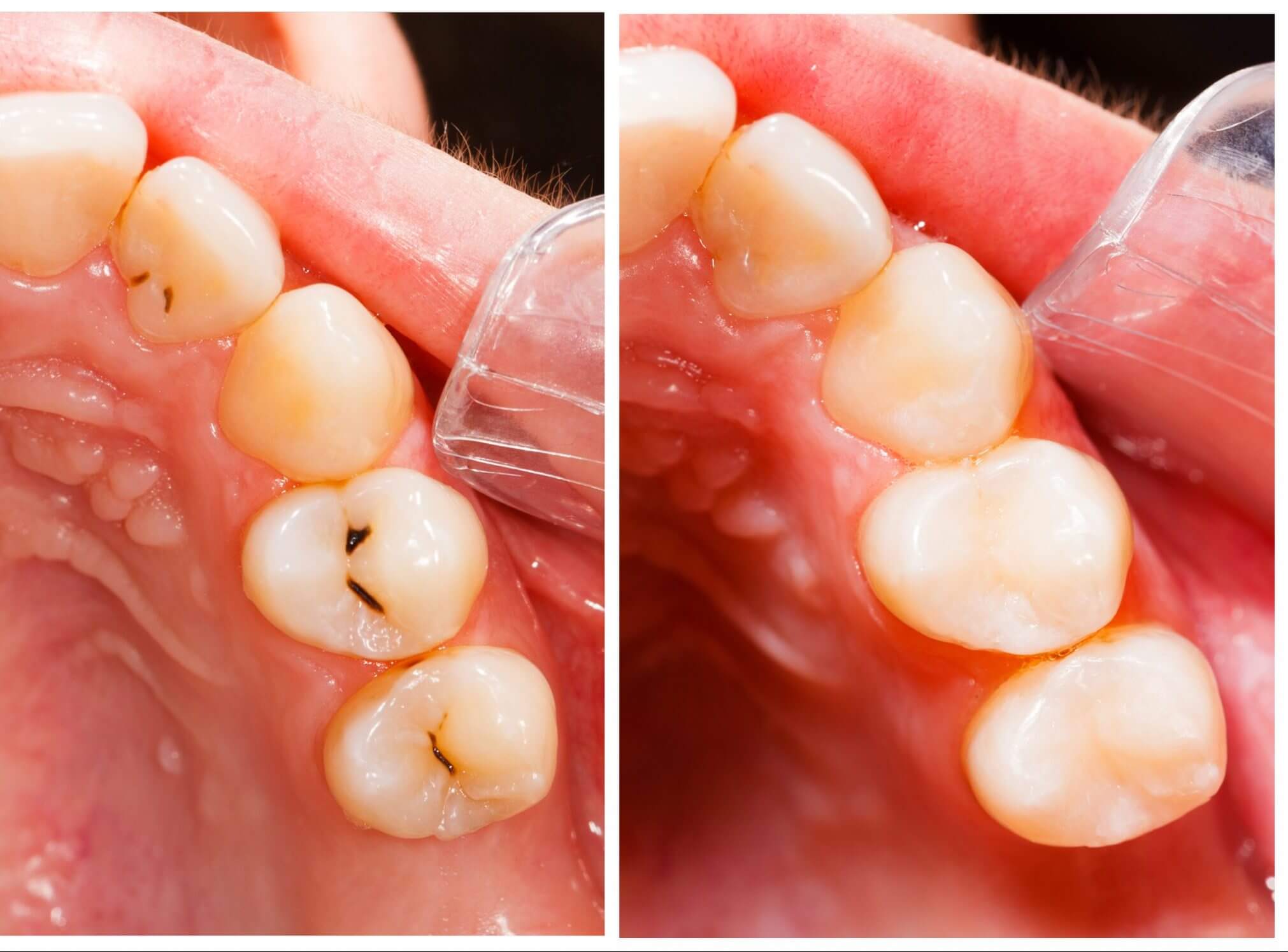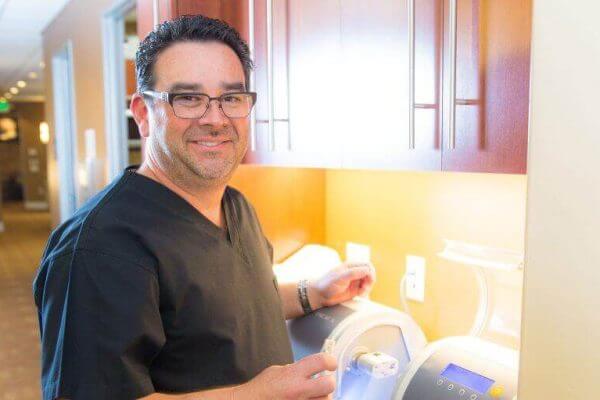According to the American Dental Association (ADA), Americans receive an estimated 175 million fillings every year. On average, the typical American has three dental fillings, and approximately 25% of Americans have more than 10 fillings.
In this article, we’ll discuss:
- What fillings are
- How fillings are placed in the mouth
- Options for fillings, including metal fillings and white cavity fillings
- Removing amalgam fillings
- Options for fillings on front teeth
- When crowns or veneers are needed rather than fillings.

What Is Filling In Teeth?
A filling is used to treat small holes (cavities) in the teeth. In the simplest terms, cavities are damaged areas on the hard surface of teeth. (Another commonly used term is tooth decay.) To treat a cavity, a dentist removes any tooth tissues that is decayed. The resulting space is replaced with a white filling in tooth. If a cavity is left untreated, the decay will continue to worsen and will result in more serious dental problems.
Fillings can also be used to repair damage caused by fractures or cracks in the teeth. The fillings help to restore and maintain tooth structure and prevent additional damage to the teeth.
How Are Fillings Placed In the Mouth?
In many dentist offices, the process for placing fillings is as follows.
- A numbing gel is used on the gums, and then an injection of a local anesthetic is used to reduce any pain from the process.
- Removal of Decayed Area. The decayed areas of the tooth are removed with a drill.
- Filling the Hole. The remaining hole in the tooth is filled with filling material (either metal or composite). If a composite filling material is used, a special light may be used to harden (“cure”) the filling.
- Polishing and Adjustment. The final step is polishing and adjusting the filling so it feels good in the mouth.
However, at Lakefront Family Dentistry, our dentists can perform a Solea laser filling, which uses an advanced dental laser that eliminates the need for numbing and anesthesia. Our dentists remove the decayed areas with the laser—quickly treating cavities without pain. The white cavity filling material is then applied, polished, and adjusted as needed.
Metal Tooth Fillings
Metal fillings have long been used in the dental field. Although these types of fillings can be made of a variety of different metals, most of them are an amalgam. An amalgam is a mixture of various metals, including silver, tin, copper, and mercury. These types of fillings are quite durable and are usually used in areas involving great force and pressure, such as on molars. However, these types of fillings are considered to be less attractive.
White Cavity Filling
In contrast to metal fillings, a white cavity filling is made of tooth-colored dental composite. These composite resins were first developed in the 1960s and have been growing in popularity ever since. Over time, the dental composites used in white cavity fillings have been refined and improved—making them stronger and more durable.
Many patients prefer a white tooth filling for cosmetic reasons, including the ability to match the composite to the color of a patient’s teeth. In teeth filling before and after photos, the majority of patients prefer the look of white cavity fillings to metal fillings.
Benefits of White Cavity Fillings
The benefits of these types of fillings include:
- Less sensitivity to hot and cold. Because composite resins do not transfer heat as quickly as metal, patients with white tooth fillings are less likely to experience heightened sensitivity when drinking hot beverages or eating cold foods (such as ice cream).
- Unlike silver amalgam fillings that can expand and contract due to changes in temperature, white cavity fillings remain stable.
- Natural-looking. White tooth fillings blend in with the rest of a patient’s teeth, making them less noticeable.
Amalgam Filling Removal
Some patients who have traditional metal fillings opt for amalgam removal for cosmetic reasons. This process involves removing metal fillings and replacing them with a white tooth filling. Fortunately, the Solea laser helps to make this procedure painless and fast. Amalgam removal and replacement with white cavity fillings can be performed in a single visit.

Getting Teeth Filling on Front Teeth
Unfortunately, front teeth are not immune to cavities, which usually occur near the front gum line or in between teeth. In addition, many patients have chips on the edges of their front teeth, which require a chipped tooth filling.
Because of the prominence and visibility of the front teeth, white tooth filling is ideal for fillings used on the front teeth because they can be matched to the existing tooth color—making the fillings much less noticeable and natural-looking.
Maintaining White Cavity Fillings
With proper care, white composite fillings can last for years. Following basic oral hygiene practices and following the tips below can help to maintain fillings.
- Use a soft-bristled toothbrush to brush teeth with fluoride toothpaste twice a day for two minutes.
- Regularly floss teeth using dental floss or a water flosser.
- Reduce or eliminate sugary drinks and snacks.
- Don’t use teeth as tools (g., ripping open packages).
- Avoid chewing on inedible objects (g., pen caps).
- Don’t chew on ice or hard foods (g., nuts).
- Visit a dentist twice a year for a cleaning and check-up.
Options for Tooth Filling
When tooth decay or damage is too extensive, fillings may not be an option. In these cases, our doctors may recommend that patients receive a dental crown or porcelain veneers.
- Dental Crowns. Think of a dental crown as a “cap” for a damaged tooth. Crowns are used to protect, cover, and restore teeth when fillings are not a viable option. At Lakefront Family Dentistry, we offer CEREC crowns, which can be created and placed in a single visit. CEREC stands for Chairside Economical Restoration of Esthetic Ceramics. Simply put, this unique and technologically advanced system creates high-quality, custom-fitted ceramic crowns in the office in minutes.
- Porcelain Veneers. Veneers are thin coverings placed over the visible parts of a tooth. The veneers look like natural teeth and are used to correct dental issues such as chipped or worn teeth, crooked or misshapen teeth, uneven spacing, and stained teeth that cannot be whitened. Unlike CEREC crowns, porcelain veneers require more than one visit to complete.
Contact Lakefront Family Dentistry at (951) 244-9495 to schedule a consultation or make an online appointment to discuss your options for white cavity filling, amalgam filling removal, CEREC crowns, or porcelain veneers.



